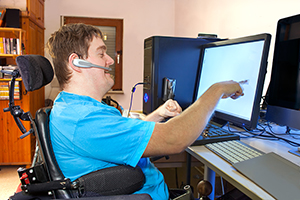Workplace Inclusivity for People With Disabilities: Creating a Welcoming Environment for All
 This is part two of a two-part blog post contributed by Abby King, accommodation specialist at University of Kansas, and William Budding, HR coordinator at Harvard University’s School of Dental Medicine, both of whom are alumni of CUPA-HR’s Wildfire program for early-career higher ed HR professionals. Read part one — Workplace Inclusivity for People With Disabilities: Accommodating Specific Needs.
This is part two of a two-part blog post contributed by Abby King, accommodation specialist at University of Kansas, and William Budding, HR coordinator at Harvard University’s School of Dental Medicine, both of whom are alumni of CUPA-HR’s Wildfire program for early-career higher ed HR professionals. Read part one — Workplace Inclusivity for People With Disabilities: Accommodating Specific Needs.
Most HR professionals are familiar with how to meet the requirements of the Americans with Disabilities Act (ADA). But what about going beyond compliance to ensure that inclusion of people with disabilities is part of an organization’s diversity and inclusion strategy at a higher level?
What Benefits a Few Benefits All
A December 2017 article in Harvard Business Review makes the case that on an organizational level, workers with disabilities contribute much in the way of innovative thought and creative solutions, which benefits the whole enterprise. What’s more, the inclusive practices you implement to support people with disabilities can support employees without disabilities in ways you may not expect. For example, making your organizational events inclusive by adding closed captioning for speakers not only supports someone with a hearing impairment, but also makes sense for people watching in a noisy cafeteria or people who wish to watch quietly at their desks.
By thinking holistically about inclusivity, you may be creating easier access for people you didn’t know were missing out. Anecdotally, there is feedback across organizations that people have avoided events or gatherings because they didn’t believe they would be able to participate successfully. It’s not uncommon to hear excuses such as, “No one who’s attending needs a ramp, so why should we add one?” When, in reality, the one person who needs the ramp never attends because you don’t provide it. Additionally, ramps serve anyone using crutches, older individuals with limited mobility and, if an event is open to the public, those with baby strollers or other rolling equipment.
The key here is not to create a comprehensive list of every scenario in which one might need an accommodation. On the contrary, you shouldn’t need a specific scenario to think inclusively. By implementing inclusive workplace practices from the get-go, workers of all abilities can come in and benefit from resources and set-ups which are already available, rather than an organization having to retrofit or adjust current workplace practices as needs arise. When you’re strategic about inclusivity, you’ll see the benefit to many individuals in your community — whether or not they have voiced a need in the past.
Resources to Get You Started
How can we think about creating inclusive space without thinking of every disability, every need and every scenario? It may seem daunting to create an all-inclusive, all-welcoming environment for everyone from the start. What if this is a burden on finances or on other staff? How do we ensure everyone is included and we don’t forget anyone? Ultimately, there is no simple solution to making your workplace a perfectly inclusive environment. However, myriad resources and starting points can support you in laying the groundwork for an inclusive workplace.
Following are some resources and readings we’ve found to be helpful:
- Creative Partnerships: The Path to an Inclusive Campus
- Removing Hiring Barriers for the Disability Community
- Online Accessibility – Harvard University
- Content Accessibility – University of Kansas
- edX Course: Introduction to Inclusive Talent Acquisition
- Planning an Accessible Event
Beyond Compliance
Inclusion is a broader, deeper concept than simply making sure you’re compliant with the ADA. As HR practitioners and agents of change, we are on the front lines of shaping culture in the workplace and have some responsibility for promoting what a diverse, inclusive workplace should look like. We can work collectively with leadership, managers, support staff, faculty and students to not only accommodate employees on a one-off basis, but also to create a work environment which includes all members and welcomes diversity of perspective.
If you’re attending the CUPA-HR annual conference later this month and you’d like to learn more about creating an inclusive environment for employees with disabilities, be sure to check out the following sessions:
- Empowering All: The Use of Mentoring for Disability Inclusion – concurrent session and microsession
- Meeting Disability With Creativity and Understanding
October is National Disability Employment Awareness Month. Visit the Department of Labor’s Office of Disability Employment Policy web page to learn how employers can create an inclusive workplace for employees with disabilities.


